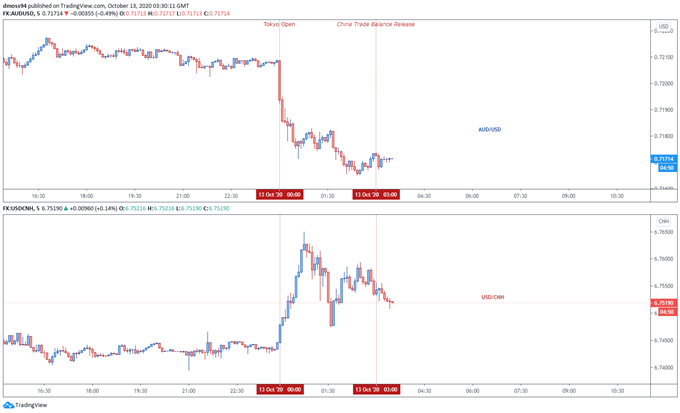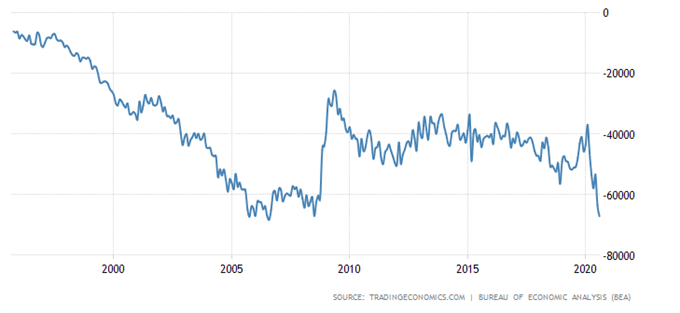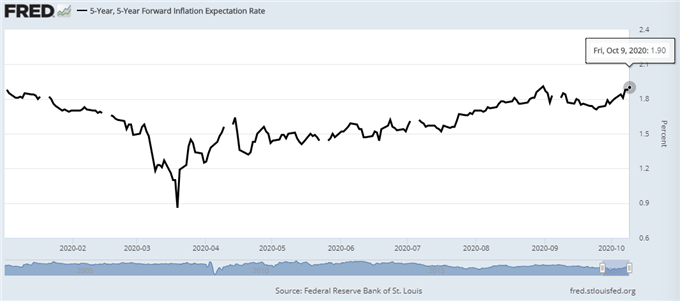Australian Dollar, AUD/USD, US-China Trade War, US Presidential Elections – Talking Points:
- The Australian Dollar continues to consolidate above key support despite China’s trade balance surplus unexpectedly narrowing in September.
- The upcoming US presidential elections will likely define the path forward for US-China relations and in turn the long-term outlook for risk-sensitive assets.
- Joe Biden’s substantial lead in the polls may begin to underpin market sentiment as investors price in a less volatile relationship between Washington and Beijing.
Australian Dollar Unfazed by China Trade Balance Release
The Australian Dollar continued to trade in a reasonably tight range even though China’s trade balance surplus unexpectedly narrowed in September, as exports rose by 9.9% (est. 10%) and imports surged 13.2% (est. 0.4%) on an annual basis.
Although the trade surplus grossly undershot market estimates by over $20 billion, the substantial drop-off was due to the marked increase in imports, which suggests that China’s economic recovery has been robust enough to precipitate a surge in foreign purchases by Chinese nationals.
Nevertheless, the absence of a notable reaction to the recent data print suggests that market participants are turning their focus towards the battle for the US Presidency, with the winner ultimately defining US-China relations and in turn the long-term outlook for risk-sensitive assets.

AUD/USD, USD/CNH 5-minute chart created using TradingView
US Presidential Elections to Dictate Risk Appetite
Polling data may dictate near-term price action in the run up to the US presidential elections on November 3, as the divergence of opinions between the incumbent President and his Democratic challenger on the ongoing trade war with China begins to drive the binary risk-on, risk-off dynamic seen in financial markets.
President Donald Trump launched a barrage of tariffs and various other trade barriers on Beijing in January of 2018, with the goal of reducing the United States’ ballooning trade deficit and promoting the domestic manufacturing industry.
However, the President’s two-year trade war has instead cost an estimated 300,000 Americans their jobs and resulted in $1.7 trillion being wiped off the stock prices of US companies because of tariffs imposed on imports from China, according to research from the Federal Reserve Bank of New York.
Moreover, at the start of 2019 - in the middle of the trade war - the deficit ballooned to its widest levels in over a decade, despite Trump's efforts to substantially reduce the nation’s ever widening trade balance. Of course, it must be noted that the deficit did narrow markedly between 2019 and 2020, only to sharply widen amid the coronavirus pandemic.
United States Balance of Trade




Nevertheless, the President’s hard-line views on China appear to have caused more damage to the local economy than good and could be a fundamental reason why market participants have appeared relatively unfazed by the breakdown in Congressional stimulus talks, with only 21 days until the US Presidential Election.
The US benchmark S&P 500 index has climbed over 5.5% higher in the month of October, despite the shifting focus of the Senate from the provision of a much-needed fiscal aid package to ensuring that the President’s Supreme Court nomination, Amy Coney Barrett, is successfully confirmed before Election Day.
Furthermore, the dovish warning from Federal Reserve Chairman Jerome Powell that the absence of “an additional pandemic-related fiscal package” could see growth “decelerate at a faster-than-expected pace in the fourth quarter” has had surprisingly little effect on sentiment, with the market’s fear gauge – the CBOE Volatility Index (VIX) – continuing to track below 30 after spiking to a fresh three-month high on September 4 (38.28).

This suggests that investors may be looking beyond November 3 and to a Joe Biden presidency, that is expected to bring with it substantial fiscal stimulus – if the Senate flips to a Democratic majority – and a more stable relationship between the world’s two largest economies.
In fact, the notable turn higher in inflation expectations appears to coincide with the former Vice President’s surge in the polls and could be indicative of a market pricing in a Democratic administration, given Mr Trump trails Mr Biden by the widest margin since polling began and holds double the deficit he had against Hillary Clinton at the same point in 2016.
Therefore, the growing likelihood of a Biden win in November could see market participants begin to price in a less vitriolic US-China relationship, which would probably put a premium on the trade-sensitive Australian and New Zealand Dollars, and in turn drag on the haven-associated US Dollar and Japanese Yen.

Data Source – RealClearPolitics, Bloomberg



-- Written by Daniel Moss, Analyst for DailyFX
Follow me on Twitter @DanielGMoss




